Georges de La Tour | |
|---|---|
| Born | 13 March 1593 Vic-sur-Seille, Duchy of Lorraine |
| Died | 30 January 1652 (aged 58) Lunéville, Duchy of Lorraine |
| Notable work | The Fortune Teller Joseph the Carpenter Magdalene at a Mirror The Card Sharp with the Ace of Diamonds |
| Movement | Baroque |
| Patron(s) | Henry II, Duke of Lorraine |
| Signature | |

Georges de La Tour (13 March 1593 – 30 January 1652) was a French Baroque painter, who spent most of his working life in the Duchy of Lorraine, which was temporarily absorbed into France between 1641 and 1648. He painted mostly religious chiaroscuro scenes lit by candlelight.
Personal life
Georges de La Tour was born in the town of Vic-sur-Seille in the Diocese of Metz, which was technically part of the Holy Roman Empire, but had been ruled by France since 1552. Baptism documentation revealed that he was the son of Jean de La Tour, a baker, and Sybille de La Tour, née Molian. It has been suggested that Sybille came from a partly noble family.[1] His parents had seven children in all, with Georges being the second-born.
La Tour's educational background remains somewhat unclear, but it is assumed that he traveled either to Italy or the Netherlands early in his career. He may possibly have trained under Jacques Bellange in Nancy, the capital of Lorraine, although their styles are very different. His paintings reflect the Baroque naturalism of Caravaggio, but this probably reached him through the Dutch Caravaggisti of the Utrecht School and other Northern (French and Dutch) contemporaries. In particular, La Tour is often compared to the Dutch painter Hendrick Terbrugghen.[2]
In 1617 he married Diane Le Nerf, from a minor noble family, and in 1620 he established his studio in her quiet provincial home-town of Lunéville, part of the independent Duchy of Lorraine which was occupied by France, during his lifetime, in the period 1641–1648. He painted mainly religious and some genre scenes. He was given the title "Painter to the King" (of France) in 1638, and he also worked for the Dukes of Lorraine in 1623–4, but the local bourgeoisie provided his main market, and he achieved a certain affluence. He is not recorded in Lunéville between 1639 and 1642, and may have traveled again; Anthony Blunt detected the influence of Gerrit van Honthorst in his paintings after this point. He was involved in a Franciscan-led religious revival in Lorraine, and over the course of his career he moved to painting almost entirely religious subjects, but in treatments with influence from genre painting.[2]
Georges de La Tour and his family died in 1652 in an epidemic in Lunéville. His son Étienne (1621-1692) was his pupil.
Works
_Saint_Jerome_lisant_Musee_Lorrain.JPG.webp)
La Tour's early work shows influences from Caravaggio, probably via his Dutch followers, and the genre scenes of cheats—as in The Fortune Teller—and fighting beggars clearly derive from the Dutch Caravaggisti, and probably also his fellow-Lorrainer, Jacques Bellange. These are believed to date from relatively early in his career.
La Tour is best known for the nocturnal light effects which he developed much further than his artistic predecessors had done, and transferred their use in the genre subjects in the paintings of the Dutch Caravaggisti to religious painting in his. Unlike Caravaggio his religious paintings lack dramatic effects. He painted these in a second phase of his style, perhaps beginning in the 1640s, using chiaroscuro, careful geometrical compositions, and very simplified painting of forms. His work moves during his career towards greater simplicity and stillness—taking from Caravaggio very different qualities than Jusepe de Ribera and his Tenebrist followers did.[2]

He often painted several variations on the same subjects, and his surviving output is relatively small. His son Étienne was his pupil, and distinguishing between their work in versions of La Tour's compositions is difficult. The version of the Education of the Virgin in the Frick Collection in New York is an example, as the Museum itself admits. Another group of paintings (example left), of great skill but claimed to be different in style to those of La Tour, have been attributed to an unknown "Hurdy-gurdy Master". All show older male figures (one group in Malibu includes a female), mostly solitary, either beggars or saints.[3]

After his death at Lunéville in 1652, La Tour's work was forgotten until rediscovered in 1915 by Hermann Voss, a German art historian who would later become head of Hitler's Führermuseum;[4] some of La Tour's work had in fact been confused with Vermeer, when the Dutch artist underwent his own rediscovery in the nineteenth century.
In film
Director Peter Greenaway has described La Tour's work as a primary influence on his 1982 film The Draughtsman's Contract.
Job Mocked by His Wife by La Tour appears in the 2003 Francis Veber film Le Dîner de Cons, and is a major preoccupation of the protagonist in the 1984 Muriel Spark novel The Only Problem.
A reference to a work purportedly by La Tour is featured prominently in the 2003 Merchant Ivory film Le Divorce.
Magdalene with the Smoking Flame (not Penitent Magdalene) is the painting in Ariel's grotto she longingly motions toward when she yearns to know about fire while singing "Part of Your World" in Disney's 1989 film The Little Mermaid.
Gallery
- Chiaroscuro scenes
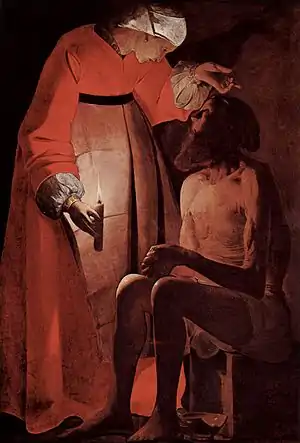 Job Mocked by his Wife, c. 1625–1650, Musée départemental d'Art ancien et contemporain, Épinal, France
Job Mocked by his Wife, c. 1625–1650, Musée départemental d'Art ancien et contemporain, Épinal, France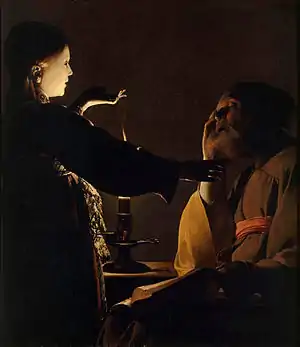 The Dream of St. Joseph, c. 1628–1645, Musée des Beaux-Arts de Nantes
The Dream of St. Joseph, c. 1628–1645, Musée des Beaux-Arts de Nantes

 Nativity, 1644, Louvre
Nativity, 1644, Louvre The Newborn Christ, c. 1645–1648, Museum of Fine Arts of Rennes
The Newborn Christ, c. 1645–1648, Museum of Fine Arts of Rennes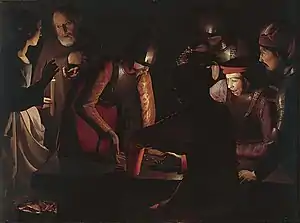
 The education of the Virgin, c. 1650, The Frick Collection
The education of the Virgin, c. 1650, The Frick Collection The smoker, 1646, Tokyo Fuji Art Museum
The smoker, 1646, Tokyo Fuji Art Museum The Flea-Catcher, 1638, Musée Lorrain, Nancy
The Flea-Catcher, 1638, Musée Lorrain, Nancy Saint Andrew in the Albi Apostles series, c. 1620
Saint Andrew in the Albi Apostles series, c. 1620 The Repentant Magdalene, c. 1635-1640, National Gallery of Art
The Repentant Magdalene, c. 1635-1640, National Gallery of Art
- Other
 The Cheat with the Ace of Clubs, c. late 1620s, Kimbell Art Museum, Fort Worth, Texas. Another version (with Diamonds and slightly different clothes) is in the Louvre.
The Cheat with the Ace of Clubs, c. late 1620s, Kimbell Art Museum, Fort Worth, Texas. Another version (with Diamonds and slightly different clothes) is in the Louvre. The Fortune Teller, 1633–1639, Metropolitan Museum of Art
The Fortune Teller, 1633–1639, Metropolitan Museum of Art
.jpg.webp) The Hurdy-Gurdy Player, c. 1610–1630, Prado Museum
The Hurdy-Gurdy Player, c. 1610–1630, Prado Museum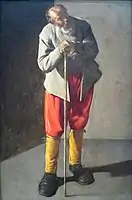 Portrait of an Old Man, c. 1624–1650, De Young Museum, San Francisco
Portrait of an Old Man, c. 1624–1650, De Young Museum, San Francisco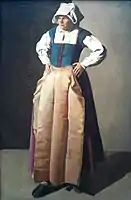 Portrait of an Old Woman, c. 1624–1650, De Young Museum, San Francisco
Portrait of an Old Woman, c. 1624–1650, De Young Museum, San Francisco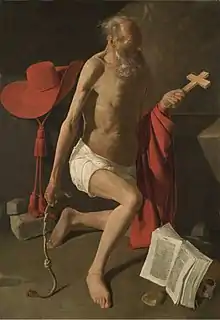
Galleries containing La Tour's works
Canada
- Art Gallery of Ontario, Musée des Beaux-Arts de l'Ontario, Toronto, Ontario
France
- Musée des Beaux-Arts de Dijon
- Musée des Beaux-Arts de Nancy in Nancy, former capital of Lorraine, has the largest collection.
- Musée des Beaux-Arts de Nantes
- Musée des Beaux-Arts de Rennes
- Musée de Bergues
- Musée départemental d'Art ancien et contemporain, Épinal
- Musée départemental Georges-de-La-Tour, Vic-sur-Seille
- Museum of Grenoble
- Musée Lorrain, Nancy
- Musée du Louvre, Paris
- Musée Toulouse-Lautrec, Albi
Germany
- Gemäldegalerie, Berlin
Japan
- The National Museum of Western Art, Tokyo
- Tokyo Fuji Art Museum, Tokyo
Spain
- Museo del Prado, Madrid
Sweden
- Nationalmuseum, Stockholm
United Kingdom
- Preston Hall Museum in Stockton-on-Tees, England, has The Dice Players.
- The Leicester Museum & Art Gallery holds 'The Choirboy'
Ukraine
United States
- Cleveland Museum of Art, Cleveland, Ohio
- Chrysler Museum of Art, Norfolk, Virginia
- Seattle Art Museum, Seattle, Washington
- De Young, San Francisco
- Frick, New York
- Getty Center, Los Angeles, California
- Kimbell Art Museum, Fort Worth, Texas
- Los Angeles County Museum of Art, Los Angeles, California
- Metropolitan Museum of Art, New York
- National Gallery of Art, Washington, D.C.
See also
Notes
References
- Conisbee, Philip. “An Introduction to the Life and Art of Georges de La Tour,” in Philip Conisbee (ed.), Georges de La Tour and His World, exh. cat. Washington, DC, National Gallery of Art; Fort Worth, Kimbell Art Museum 1996, pp.13-147.
- Furness, Sophia Mary Maud. Georges de la Tour of Lorraine, 1593–1652. Published by Routledge and Kegan Paul Ltd, London, 1949. OCLC 886297484.
- Judovitz, Dalia. “Georges de La Tour and the Enigma of the Visible”, New York, Fordham University Press, 2018. ISBN 0-82327-744-5; ISBN 9780823277445.
- Le Floch, Jean-Claude. La Tour, Le Clair et L'Obscur, Herscher, 1995.
- Le Floch, Jean-Claude. Le signe de contradiction : essai sur Georges de La Tour et son oeuvre, Presses Universitaires de Rennes 2, 1995.
- Thuilier, Jacques. Georges de La Tour, Flammarion, 1992.
- Wright, Christopher. The Art of the Forger, 1984, Gordon Fraser, London. ISBN 0-86092-081-X.
External links
- Georges de La Tour at Gallery of Art
- Attributed painting at the Kimbell Art Museum of Fort Worth
- Georges de La Tour. Pictures and Biography
- Judovitz, Dalia. Georges de La Tour and the Enigma of the Visible, 2017.
- Georges de la Tour in Oxford Bibliographies in Renaissance and Reformation.
- Georges de La Tour at Fondation Berger

